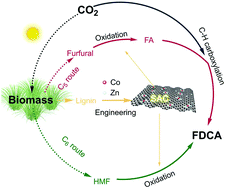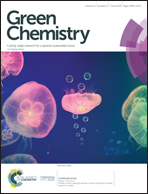Convergent production of 2,5-furandicarboxylic acid from biomass and CO2†
Abstract
We report a rationally designed process for complete lignocellulose conversion and CO2 utilization to convergently produce 2,5-furandicarboxylic acid (FDCA) that can be used in bioplastics and resins. The phenolic motif of the lignin structure enables the assembly of metal–lignin hybrids to fabricate a single-atom cobalt over nitrogen-doped carbon (Co SAs/N@C) catalyst. The Co SAs/N@C catalyst exhibits outstanding performances in the transformation of carbohydrate-based hydroxymethylfurfural (HMF) and furfural into FDCA and furoate, respectively. Importantly, during the furfural oxidation, Cs2CO3 is used as a base additive, which can also promote the carboxylation of the 5 position C–H of furoate in the subsequent reaction to give the desired FDCA using CO2 as the C1 source.



 Please wait while we load your content...
Please wait while we load your content...